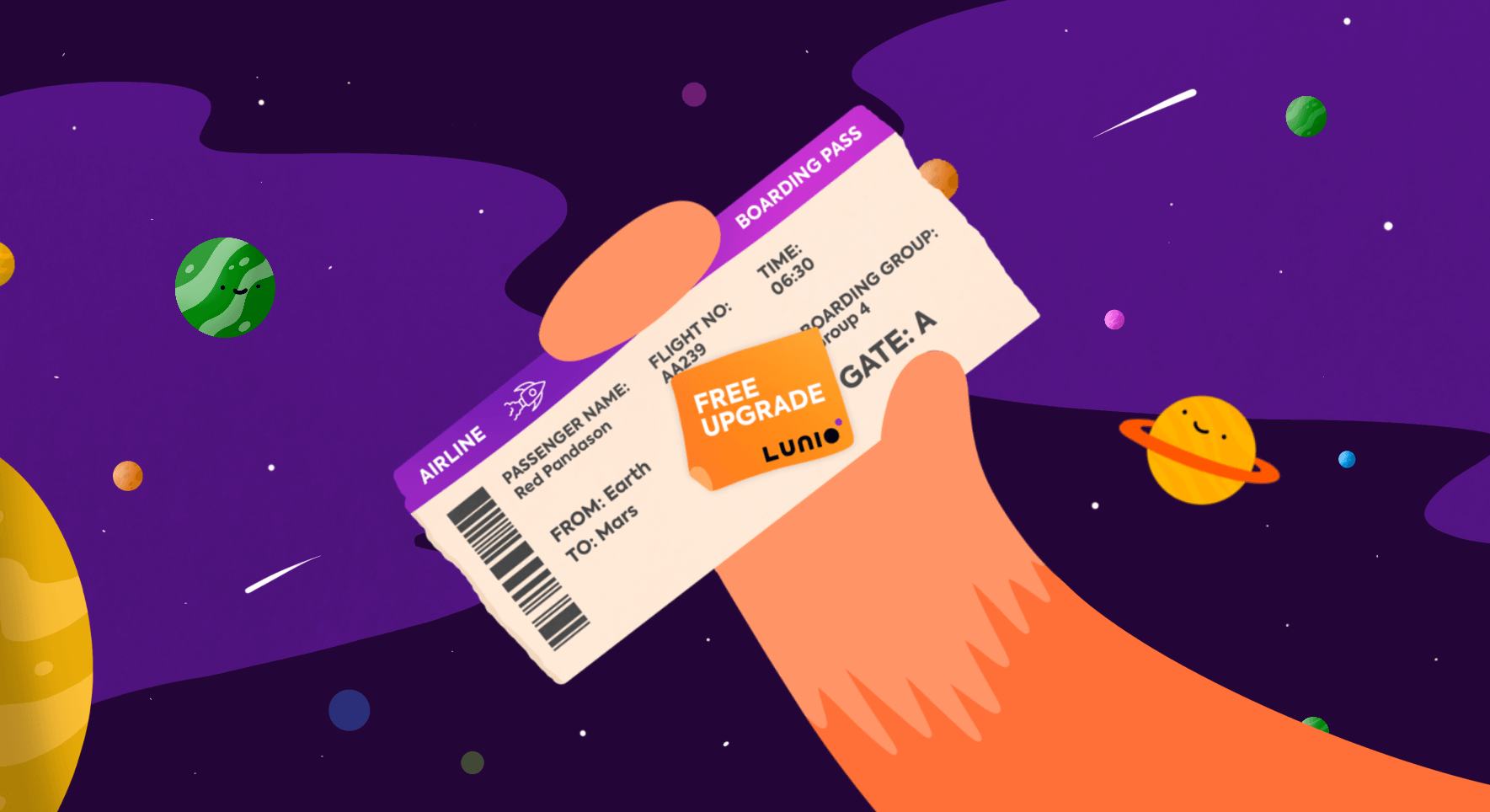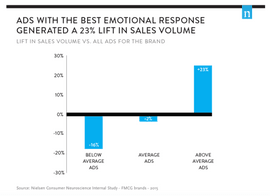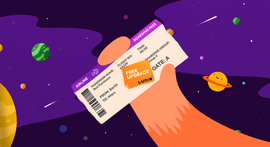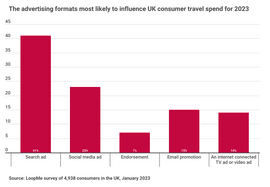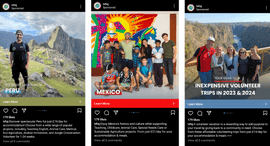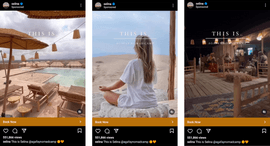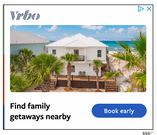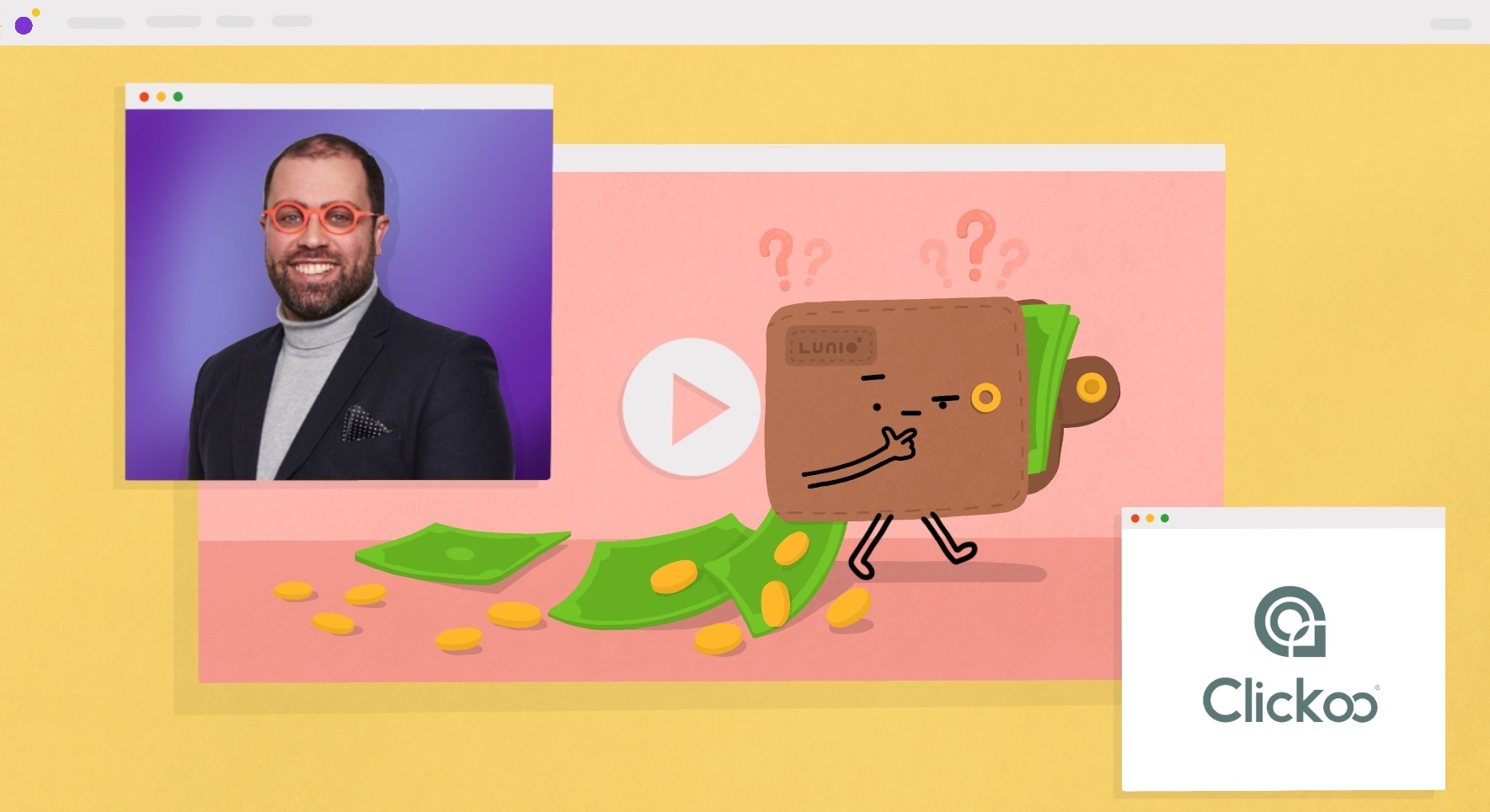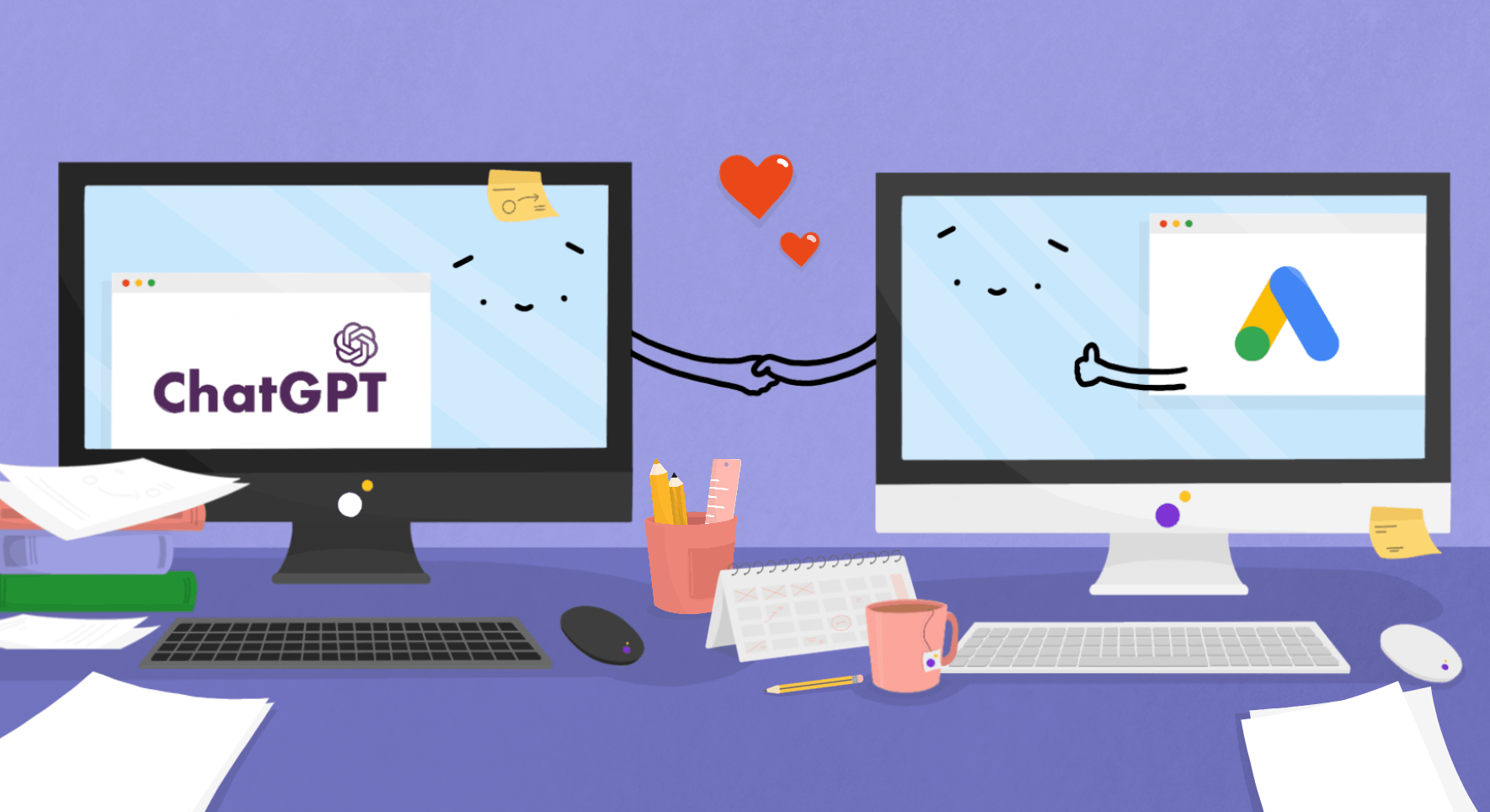Travel is a source of passion, excitement, and joy for many people. Whether they travel for adventure or relaxation, to explore the world or break away from the nine-to-five, travel offers an exhilarating respite from our day-to-day lives.
Because of this, booking travel is usually emotionally-charged. So as travel marketers, you must tap into these emotions in your travel ads to drive bookings and improve customer satisfaction. A study by Nielsen found ads that generated a higher-than-average emotional response led to a 23% uplift in sales:
In this article, we’ll explore:
- Why emotional advertising is the key to travel marketing success
- How different ad types can be used to attract would-be travellers and tourists
- How the best travel marketing campaigns successfully elicit emotions in their PPC advertising efforts.
Why Emotional Advertising Is Essential for Travel Marketers
The idea of travel sells itself. Plenty of travel companies post attractive photos of far-flung destinations and expect these to do the work for them.
But images alone don’t create enough wanderlust to make people actually book the trip. Travel marketers need to connect these images to experiences. As Tracey Lanza, senior VP of Integrated Marketing at Brand USA, says:
There has to be something that is absolutely special and magical about the trip. Using the voices of the people, who can tell you the hotspots, the cool spots, the iconic spots, is a great way to tell the story.
Persuading someone to get down to the brass tacks booking of a holiday is difficult. And it’s why emotional marketing is so important in the travel industry. You must find creative ways to tell stories about a place that elicit specific emotions in your would-be customers. Statistics suggest this is key both before and after a trip has begun:
- Two thirds of travellers do online research before making any decision relating to travel
- 48% of experience bookings take place when travellers arrive at their destination
- 81% of travellers say providing personalised travel experiences to customers is very important
- 76% of travel marketers say that finding creative, personal ways to engage travellers has made a measurable difference in their multichannel campaigns.
With so many advertising channels and formats now available, there are plenty of opportunities to attract and inspire tourists and travellers. Your PPC travel marketing campaigns are the best place to start, as you can make immediate changes to evoke emotion, leading to more conversions and a better return on your investment.
We’re about to analyse five PPC travel ads to see how you can use their emotional marketing strategies to improve your paid advertising. For the purposes of this article, we’ve assumed the rest of your PPC campaign (such as keywords, bid strategies, and campaign structure) have all been optimised.
You’ll also want to make sure your ad spend is protected against bots and fake traffic, as this can eat into your marketing budget with zero gain. Without these optimisation measures in place, you’re unlikely to see results even with the most creative travel ads.
If your campaigns need a little TLC before you start, take a look at these guides for optimising paid ads:
- How to Optimise Google Performance Max Campaigns [Webinar]
- 11 Actionable PPC Tips and PPC Optimization Strategies
- 14 Common PPC Mistakes Every Marketer Should Avoid
Expedia: Travel Ads PPC Case Study
First, let’s take a look at an award-winning campaign for Expedia, an established online travel agency. With the help of their marketing agency, Expedia sought to reposition travel as an investment in personal growth. Here’s a video from their ‘Travel Yourself Interesting’ campaign:
As an advert, it’s quirky, witty, and fun — making it highly watchable and shareable (unsurprisingly, this campaign performed best on social media). But it also speaks to people’s inner desires (to be the life of the party) and fears (what if I’m actually not that interesting?). So while this ad is designed to entertain, it’s also a fantastic example of emotional marketing.
And it was a big success. As well as winning a bronze at the 2014 IPA Effectiveness Awards, this campaign also led to an 8% increase in gross booking value in the UK, and a 33% increase in France.
Let’s take a look at four other travel ads and see how they harness the power of emotional marketing.
1. Tap Into the Thrill of Adventure (Google Search Ad)
Search ads help your site get visitors without the investment and hassle of an SEO strategy. These ads are listed at the top and bottom of each search engine results page.
Search ads are almost entirely text-focused, so your ad copy needs to be highly emotive and compelling. Google may display an image from your extensions if you’ve added them, but these are often too small to elicit much emotion from users.
A recent study found that search ads are the most likely ad format to influence UK consumer travel spend in 2023:
So search ads are highly effective for travel marketers. But without visuals, your ad copy needs to work hard to evoke the desired emotion.
Your ad headline is the most important element. It must be unique and compelling, while also reflecting your target keyword. This is a lot to cram into 30 characters, so make good use of your ad description as well. Here, you can use up to 90 characters to touch on customer pain points and elicit feelings from users.
Let’s take a look at the example search ad below from Explore to see how it taps into the thrill of adventure:
This ad displays for the keyword “book adventure holiday”. Interestingly, it doesn’t use this (or a variation of this) in the headline. Instead, they’ve used their characters to speak directly to the adventurous spirit of those using this search term.
Having a “once-in-a-lifetime” experience “every day” is far more intriguing for people seeking an adventure travel experience than parroting the search term back to them.
The description, meanwhile, does use some of these keywords: “adventure” and “holidays” appear early on. They’ve also added social proof — 98% of customers would book again, and they’re a Feefo Gold Trusted Partner — which differentiates them from their competitors.
All this in 90 characters. And the image extension, though small, backs up their promise. This trip isn’t about relaxing on the beach; it’s about exploring unknown places and experiencing different sunsets.
2. Speak to Their Social Conscience (Social Image Ad)
Social image ads are essential on visual platforms like Instagram. A survey of almost 78,000 people found that 48% of Instagram users locate and choose holiday destinations here, so getting your social image ads right can really pay off.
Social image ads give your target audiences a visual glimpse of what they can expect from your travel experience. But it’s easy to fall into the trap of sharing spectacular scenery without adding the emotive element. So make sure your images get the reaction you want.
This campaign from International Volunteer HQ is a great example of this. It speaks to travellers��’ desire to do some good while they’re abroad:
The copy in these social image ads is direct, but it still speaks to travellers’ concerns and desires:
- “Inexpensive” is a key word in the first image. IVHQ knows this is a pain point for their potential customers, so addressing this early entices people to find out more.
- “Add purpose to your travel” is another carefully used phrase that speaks to inexperienced or solo travellers who may be worried about filling their days in an unknown country.
- The image backdrops are inviting, but it’s the people who are front and centre. This taps into people’s desire to not just visit an attractive-but-abstract destination, but to make a difference while you’re there — and feel good about yourself in the process.
- Each of the images is carefully selected to speak to a different type of socially-conscious traveller, from travellers seeking connections and community to those who want adventure and exploration.
Social image ads are about blending copy with imagery to create a sense of expectation that can only be fulfilled by booking with your brand.
3. Showcase a Relaxing Retreat (Short-Form Social Video Ad)
With the rise of TikTok and Instagram, travel marketers need to leverage the power of short-form video ads on social media. According to MMGY Global research, 34% of travellers were influenced by TikTok in 2022. And this trend is unlikely to stall any time soon.
Video is an incredibly useful tool for evoking emotion. Show what it’s like to actually be there at your destination, so people can visualise their fulfilled future selves. You can use video to build any kind of emotion: snappy supercharged videos build a sense of adventure, while calm, slow-paced videos create a more relaxing vibe. So you need to decide which emotions you’re trying to evoke before you start shooting.
High-production value video is expensive, so it’s important to test your messaging before you hire a costly production company. There’s also a danger of overrelying on destination visuals to compel people to book with you. Beautiful locations are easy to come by; it’s how they make people feel that’s important.
Let’s look at some frames from this short video ad from Selina, a global accommodation provider:
This short-form video ad by Selina is part of a campaign to increase brand awareness. While the call-to-action invites you to book a trip, the concise description (simply “This is Selina” with a related account tag) subtly links the brand with what’s offered in the video: a relaxing, reinvigorating retreat.
Here’s why it works:
- Each shot in this video offers something unique: solitude, meditation, music. It’s all about evoking the desire for stillness and relaxation, an escape from everyday stresses.
- It’s clear who the target audience is (women in their late 20s to 40s) and what they can expect to feel when they visit.
- The first shot doesn’t actually reveal what “this is…”, creating a cliffhanger that’s just long enough to keep people interested. Viewers will stop scrolling and watch to find out more.
- The copy is minimal; the video does all the emotional legwork here.
Video is unique. Combine music, visuals, and copy to create an emotional experience for your potential customers before they’ve booked their trip.
4. Make Family Memories (Display Ad)
Display banner ads are among the cheapest advertisements you can run, but they’re not usually the best for conversion. With an average display network click-through rate of 0.47% in travel and hospitality, not all advertisers consider this a good use of their ad budget.
But display ads still have a place in travel marketing. Retargeting previous site visitors can help keep your brand top of mind when they’re ready to book. And with the introduction of Google’s Performance Max platform, you can also now display videos across the Google Display Network.
Take Vrbo, an online marketplace for homestays similar to Airbnb. Vrbo uses display advertising to sell cosy winter breaks for families:
This ad takes a different tack to many other travel ads, which show bright, sunny destinations. Instead, Vrbo creates an atmosphere that manages to be both inviting and realistic. Here’s why this ad works:
- The voiceover explains Vrbo’s USP (having the entire place to yourself), but the emotion is evoked by the visuals. So even if the video is muted (which most display ads will be by default) users still get that comforting glow when they see this ad.
- The video shows the point of arrival at the destination. This is one of the most exciting times for kids (and a moment of relief for parents), so focusing on this trip highlight is a smart way to harness the anticipation of a holiday.
- The dark, dusky lighting is unusual for a travel ad, but it works to create a cosy, family-oriented atmosphere, helping it stand out from the standard summer holiday ads.
Vrbo also uses retargeting ads to remind you of previous homes you’ve looked at. So when you’re ready to buy, you’ll recall these first:
Get Even More From Your Travel Ad Budget
Boosting the emotional impact of your travel ads can give your campaign the boost it needs to drive conversions and bookings. But you also need to protect your campaigns from invalid traffic to get the absolute most from them.
Lunio has helped travel companies including Norwegian Air Shuttle and Volotea save thousands in wasted ad spend. We’ve reduced invalid clicks by 18% for Volotea, saving them £44,000 every month.
Calculate how much Lunio could save you using our ad cost saving calculator.
Perfect Bid Management
Discover our 14-day trial to target genuine users and optimise your bid management strategies.
